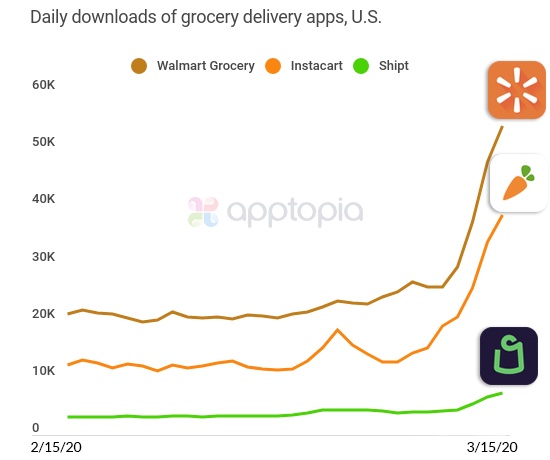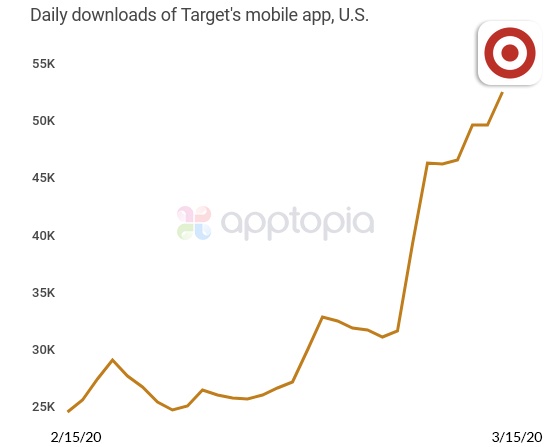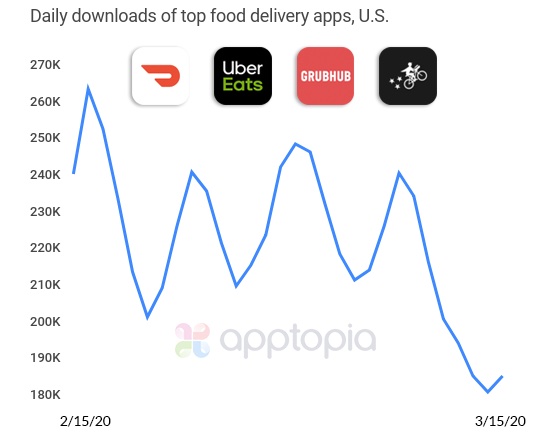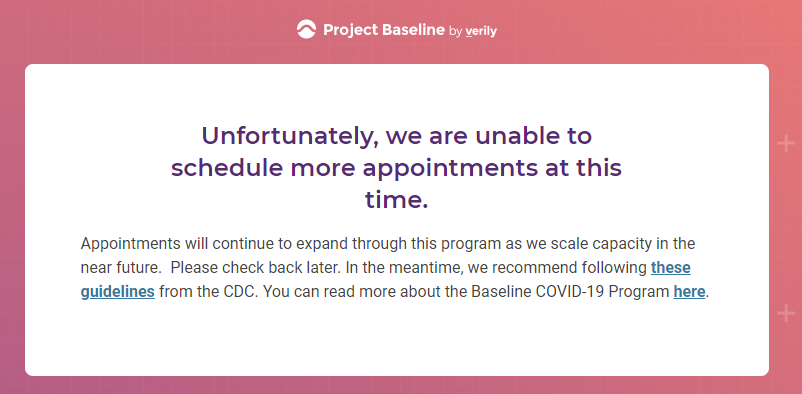
A blog about how-to, internet, social-networks, windows, linux, blogging, tips and tricks.
16 March 2020
Grocery delivery apps see record downloads amid coronavirus outbreak
As the COVID-19 pandemic spreads across the U.S., grocery delivery apps have begun seeing record numbers of daily downloads, according to new data from app store intelligence firm Apptopia. On Sunday, online grocery apps including Instacart, Walmart Grocery, and Shipt hit yet another new record for daily downloads for their respective apps, the firm says.
Comparing the average daily downloads in February to yesterday (Sunday, March 15), Instacart, Walmart Grocery, and Shipt have seen their daily downloads surge by 218%, 160%, and 124%, respectively.
Typically, these apps (except for Shipt) see tens of thousands to as many as twenty thousand-plus downloads per day. But on Sunday, Instacart saw over 38,500 downloads and Walmart Grocery saw nearly 54,000 downloads, the firm says. Shipt, though hitting record numbers, saw only 7,285 downloads on Sunday. To some extent, its lower figures could be due to Target’s move to integrate Shipt’s grocery delivery service, which it owns, into its main app.

In fact, the Target app has also broken records for daily downloads, the report found. On Sunday, Target’s app saw over 53,100 daily downloads when a month ago, it was seeing 25,000+.
Walmart very recently announced it would merge its grocery delivery service into its main app, as Target has done. But for now, consumers are still seeking out and downloading its standalone grocery app at record levels.

These grocery delivery apps are in demand more than ever during this health crisis.
With government mandates to practice “social distancing,” U.S. consumers have been stocking up for long weeks to be spent at home. Stores were cleared of key supplies, like toilet paper, and several also saw long lines and crowds as panic-buying set in. Grocery delivery and pickup, meanwhile, presents an easier option — as well as one where you could limit your exposure to other people. With grocery pickup, consumers only have to interact with a single store employee from their curbside parking space. And with grocery delivery, most orders can simply be left on the doorstep with no person-to-person contact required.
Several grocery delivery services, including Instacart and others, promoted the fact they would add a “contactless” delivery option which help contribute to the huge sales boost. On Thursday, Instacart said its sales growth rates for the week was 10 times higher than the week before, and had increased by as much as 20 times in areas like California, New York, Washington, and Oregon.
Apptopia’s report didn’t analyze the impact of the coronavirus outbreak on Amazon’s grocery delivery business, which includes Amazon Fresh and Whole Foods deliveries. This is more difficult to do because Amazon grocery orders aren’t placed inside a dedicated app, as with Instacart. However, Amazon confirmed a technical glitch on Sunday affected online orders through both its grocery delivery services, which the company attributed to the increase in online shopping.
“As COVID-19 has spread, we’ve seen a significant increase in people shopping online for groceries,” an Amazon spokeswoman explained, in a statement shared with Bloomberg. “This resulted in a systems impact affecting our ability to deliver Amazon Fresh and Whole Foods Market orders [on Sunday night]. We’re contacting customers, issuing concessions, and are working around the clock to quickly to resolve the issue,” they added.
Amazon Prime is also expected to experience delays and shortages as consumers stock up on non-grocery household items, the company says.
But even as grocery delivery booms, the market for food delivery apps has not seen the same results.
Despite promises for contactless delivery from several providers, including Uber Eats, food delivery apps are not experiencing a similar surge in daily downloads. According to Apptopia, the food delivery market earlier in March was starting to cool off. It later began to pick up but then cooled off again as consumers realized the expense of ordering food compared with home cooking, and because some consumers view restaurant delivery as not being as safe as cooking at home.

Read Full Article
How can we control the coronavirus pandemic? | Adam Kucharski
As the threat of COVID-19 continues, infectious disease expert Adam Kucharski answers five key questions about the novel coronavirus, providing necessary perspective on its transmission, how governments have responded and what might need to change about our social behavior to end the pandemic. (This video is excerpted from a 70-minute interview between Kucharski and head of TED Chris Anderson. Listen to the full interview at go.ted.com/adamkucharski.)
Click the above link to download the TED talk.
Verily’s coronavirus screening site is already out of testing appointments
Last night, slightly ahead of schedule, Verily launched its much-discussed coronavirus screening site. On the site, which is only available in parts of the Bay Area, users can describe their symptoms and Verily will then direct them to a testing site if necessary. After only a few hours online, though, the site has already run out of appointments.
“Appointments will continue to expand through this program as we scale capacity in the near future. Please check back later,” the site now says, but only after you’ve gone through most of the questionnaire.
It’s obviously not Verily’s fault that the state’s testing sites are at capacity and if anything, this proves the need for a service like this on a national scale.
Originally, in a press conference on Friday, President Trump said a site Google was working on was going to be the core feature of a national testing strategy. That story changed quite a bit over the weekend as Google and Verily clarified their efforts and it became clear that the White House overpromised, but Verily then launched its pilot site ahead of schedule on Sunday night.
We have asked Verily for more information and will update this post once we hear more.
Read Full Article
Where’s the Zoom of VR?
Remote collaboration tools like Zoom are gathering massive amounts of attention as people begin working from home en masse. But, as with most trends, virtual reality seems to be sitting out this boom.
This should be surprising to absolutely no one, but the lack of widespread adoption is not for lack of trying.
Virtual reality has already had a rough couple of years. Though a handful of startups in the space have continued to raise and find customers, most have done so by either committing to tight niches or opening up their services and minimizing their reliance on VR-only audiences. All the while, investors and founders have been left to wonder whether the “presence” offered by immersing yourself wholly in a digital environment is undone by crude avatars, clunky hardware and lackluster integrations with popular work software tools.
Enterprise VR hasn’t been completely quiet. A number of startups have raised funding in recent months on the premise that the future of work has a space carved out for virtual reality applications. In the collaboration space, VR startups argue that existing platforms are static, dated and leave employees feeling disconnected. VR’s oft-espoused mantra is that inhabiting a virtual space allows people to communicate more naturally.
I recently met with Anand Agarawala, CEO of Spatial, an AR/VR collaboration tool that locked down a $14 million round of funding earlier this year. VR startups haven’t been raising rounds this large lately, but Agarawala has ambitious plans for how his collaboration platform can outdo Zoom.
Read Full Article
A campaign for period positivity | Ananya Grover
Having your period is exhausting -- and for many people across the world, menstruation is even more challenging because of stigmas and difficulty getting basic hygiene supplies, says social activist Ananya Grover. In this uplifting, actionable talk, she shares how "Pravahkriti," her campaign to spread period positivity, creatively engages with everyone to promote menstrual health, raise awareness and break taboos around periods.
Click the above link to download the TED talk.
Alphabet’s Verily launches its California COVID-19 test screening site in a limited pilot
Alphabet-owned health technology company Verily has launched the COVID-19 screening site that was first misrepresented by President Trump as a broadly focused coronavirus web-based screening and testing utility developed by Google. After a flurry of blog posts by Google and Verily over the weekend, as well as a follow-up press conference by the White House, it became clear that the screening and testing site was a Verily project, limited in scope to California residents, with a specific focus on a couple of counties for now.
That’s what launched on Monday morning (as eventually clarified by the White House) – a site hosted at Verity’s Project Baseline, which until now has acted as a portal connecting potential participants with medical research studies. The California COVID-19 risk screening and testing site provides screening and potential free testing to those who are eligible based on its criteria, which right now includes residents of Santa Clara County and San Mateo County.
In addition to being located in these places, eligible participants must also be 18 or older; a resident of the U.S.; able to speak and read English; and willing to sign a COVID-19 Public Health authorization form, according to the website. This form provides permission to Verity to collect a person’s information to be used for the screening process. Anyone looking to make use of the site must also either create a new Google account or connect their existing account in order to register.
Despite the requirement of a Google account, Verily says on its website FAQ that it “follows federal and state regulations governing the collection and use of an individual’s data,” and stores the information securely in an encrypted format. It does note that Verily staff will have direct information to identifying information about anyone who uses the site, and that information will be shared with health care professionals, lab personnel, and health officials, and that info could potentially be shared with Verily’s data technology provider partners, including Google.
The company specifically says that it will not share any info with any insurance or medical providers without direct consent, and that any information shared through the COVID-19 screening process will not be used for advertising.
What the website actually provides participants is a multi-question survey that determines initial eligibility, followed by a more in-depth questionnaire intended to asses a person’s risk relative to actually having contracted coronavirus, which is then used to determine whether to direct them to a mobile testing site where they’ll receive a nasal swab and, after “a few days” according to Verily, their test results.
Verily said in a blog post over the weekend that it is working with California Governor Gavin Newsom’s office on expanding availability of the tool to additional parts of the Bay Area and the state. The company hasn’t so far mentioned explicitly any plans to expand to other states, and when I posed the question via email I received an auto-response directing me to their blog post citing a high volume of inbound requests.
Read Full Article
Workers at America’s largest companies are not covered under coronavirus aid package
Workers at America’s largest companies are not covered under a bill passed by the House of Representatives on Friday that is supposed to support American workers impacted by the spread of the novel coronavirus.
The bill still has to be voted on by the Senate and approved before it can be signed into law, but its structure leaves a gaping hole in the prevention strategy the government has said is necessary to reduce the COVID-19 outbreak in the US.
“No American worker should worry about missing a paycheck if they’re feeling ill,” said Vice President Mike Pence at the Sunday press briefing from the Coronavirus Task Force. “If you’re sick with a respiratory illness stay home.”
However, millions of Americans potentially don’t have the ability to make that choice under the congressional aid package touted by both Democrats and Republicans. By excluding companies with more than 500 employees from the Congressional aid, the health and welfare of millions of Americans in industries providing goods, manufacturing, and vital services to most of the country is being left up to the discretion of their employers.
Details of the legislative compromise were first reported by The New York Times yesterday. And chart published by The New York Times illustrated just how many companies didn’t have paid sick leave policies in place as the coronavirus began to spread in the US (companies have changed policies to respond to the coronavirus).

Image courtesy of The New York Times
Big technology companies took the lead early this month in changing policies for their workers and by the end of last week many of the country’s largest employers had followed suit. But it looks like their work won’t be covered under the government’s current plan — and that any measures to extend sick leave and paid time off will be limited to a response to the current outbreak.
These large employers have already responded by closing stores or reducing hours in areas where most cases of the novel coronavirus have been diagnosed — and companies operating in most of those states are required by law to offer paid leave to their hourly employees and contractors.
Companies who have responded to the outbreak by changing their time-off and sick leave policies include Walmart, Target, Darden Restaurants (the owner of the Olive Garden restaurant chain), Starbucks, Lowes, and KFC, have joined tech companies and gig economy businesses like Alphabet (the parent company of Google), Amazon, Apple, Facebook, Instacart, Microsoft, Postmates, Salesforce, and Uber in offering extended leave benefits to employees affected by the coronavirus.
These kinds of guarantees can go a long way to ensuring that hourly workers in the country don’t have to choose between their health and their employment. The inability to pass a law that would cover all workers puts everyone at risk.
Without government stepping in, industries are crafting their own responses. Late Sunday, automakers including GM, Ford, and FiatChrysler joined the United Auto Workers union in announcing the creation of a coronavirus task force to coordinate an industrywide response for the automotive sector.
As the Pew Research Center noted last week, the bill proposed by House Democrats had initially proposed temporary federal sick leave covering workers with COVID-19 or caring for family members with two-thirds of their wages for up to three months; expiring in January 2021. The measure would have also guaranteed private employers give workers seven days of paid sick leave with another 14 days available immediately in the event of future public health emergencies.
Most workers have less than nine days of sick leave covered under current state legislation. There is no national mandate for paid sick leave. After one year on the job, 22 percent of workers have access to less than five days, while another 46 percent of employees can get five-to-nine days of paid sick leave. Only 38 percent of workers have between ten and fourteen days of leave.
The Pew Research Center also reported that the lack of access to paid sick leave increases as wages decline. Over 90 percent of workers receiving hourly rages over $32.21 have some form of paid sick leave. Only about 50 percent of workers who make $13.80 or less have access to some form of paid sick leave. For Americans who make under $10.80 an hour, only about 30 percent receive any sick leave.
Read Full Article
Trump says Google CEO Sundar Pichai called to apologize
At what is now a daily coronavirus press briefing at the White House, President Trump today said that Google CEO Sundar Pichai called him to apologize. What Pichai apologized for wasn’t immediately clear, but Trump then went on to praise Google’s communications team for supposedly substantiating Trump’s comments about Google’s coronavirus screening site.
“I want to thank the people at Google and Google Communications because as you know, they substantiated what I said on Friday,” said Trump. “The head of Google, who is a great gentleman — said — called us — and apologized. I don’t know where the press got their fake news, but they got it someplace. As you know, this is from Google [holds up printout of Google Communication’s statement on Twitter]. They put out a release [drops the paper on the ground] and you guys can figure it out yourselves and how that got out and I’m sure you’ll apologize. But it would be great if we could really give the news correctly. It would be so, so wonderful.”
We reached out to both Google and the White House for further clarification about this call.
What is clear, though, is that Google and Alphabet CEO Pichai today posted an update to Google’s blog that outlines Google’s efforts. In it, Pichai clears up some of the confusion and describes the work the company is doing to get more information about the virus and COVID-19 to its users, as well as the work Alphabet’s Verily life sciences unit is doing to build a screening site for the Bay Area (and potentially for a nationwide rollout).
On Friday, Trump said 1,700 Google engineers were working on this screening site — though it is a Verily project that, as best we can tell, was never meant for a consumer rollout. Google never clarified how many people were working on its efforts, but it doesn’t take 1,700 engineers to build the site Trump described.
Here is what Trump said on Friday:
“I want to thank Google. Google is helping to develop a website. It’s gonna be very quickly done — unlike websites of the past — to determine whether a test is warranted and to facilitate testing at a nearby convenient location. We have many, many locations behind us, by the way. We cover this country and large parts of the world, by the way. We’re not gonna be talking about the world right now, but we cover very, very strongly our country. Stores in virtually every location. Google has 1,700 engineers working on this right now. They have made tremendous progress.”
The Fake and Corrupt News never called Google. They said this was not true. Even in times such as these, they are not truthful. Watch for their apology, it won’t happen. More importantly, thank you to Google! https://t.co/AuvpbXNouW
— Donald J. Trump (@realDonaldTrump) March 15, 2020
Google was clearly not ready for this public statement at the time. On Friday, we contacted them a few minutes after Trump made these comments. (Trump today said the media never called Google, which was flat-out wrong). It took Google’s Verily unit almost two hours to respond and note that Verily was working on a far more limited project than the one Trump described.
On Saturday, VP Pence clarified the situation a bit by saying that Google (or Verily – because who knows at this point) would have a pilot version of the screening site ready for a test in the Bay Area by tomorrow, Monday the 16th.
“I know Google issued a statement that they are planning to launch a website,” Pence said. “I think they gave a date of Monday, March 16th and we’re working literally around the clock and I know that our whole team is working on the public and private partnership. Couldn’t be more grateful to all at the hard-working people at Google who are helping to put this website together.”
But what Google later clarified is that there are at least two different efforts here. Google’s work around bringing more information about COVID-19 to its users across its various services — and Verily’s efforts to launch a pilot website “that will enable individuals to do a risk assessment and be scheduled for testing at sites in the Bay Area.”
Today, to add a bit more confusion to this story, VP Pence said the government is working with “Google and many other tech companies,” including Google, Facebook and Amazon. At some point early in the week, there will be a website that will go up where people can fill out a questionnaire to see if they need a test. That is very much the site Trump described on Friday, but Pence didn’t clarify how much of a role Google is playing in this.
On Friday, Trump promised a nationwide website, developed by Google, that would be at the core of the government’s screening process. Google wasn’t ready for that announcement. The site didn’t exist yet. Even the limited version of that site, which wasn’t developed by Google, was ready and for the most part, a lot of us in the media probably now regret ever taking the president at his word. As of now, this is one of the most bizarre Google stories I’ve covered in recent years.
Now, it’d be great to hear more about what Pichai apologized for.
Read Full Article

